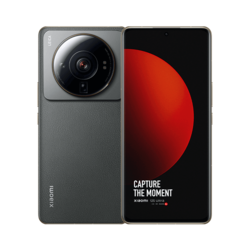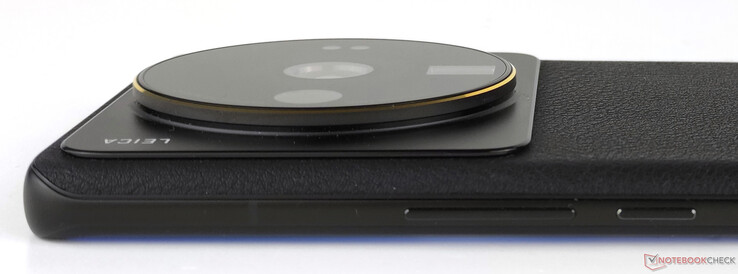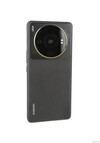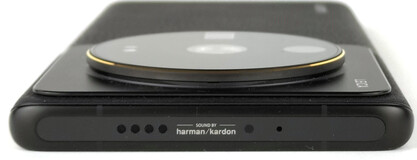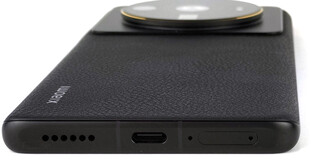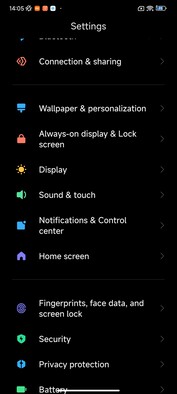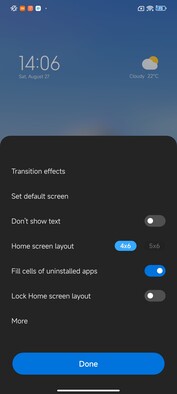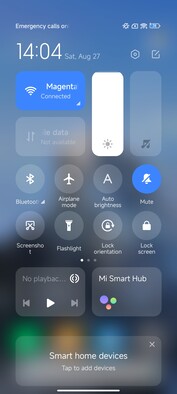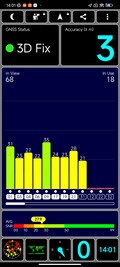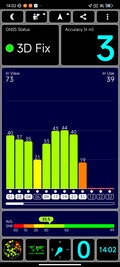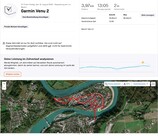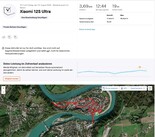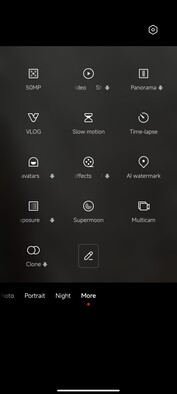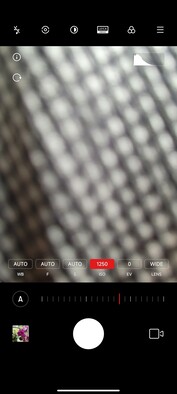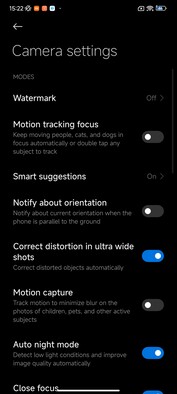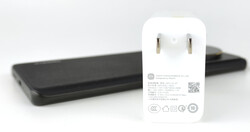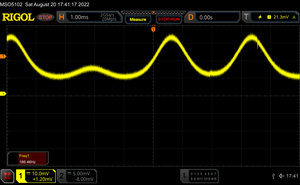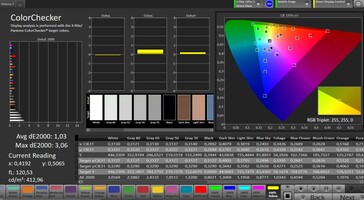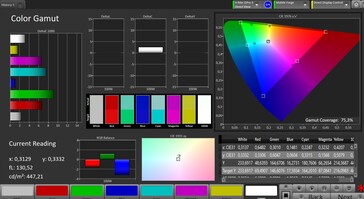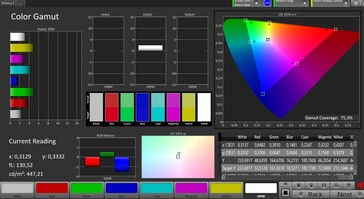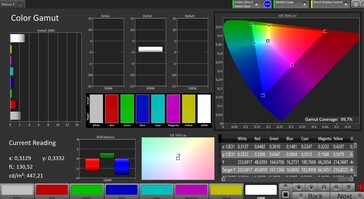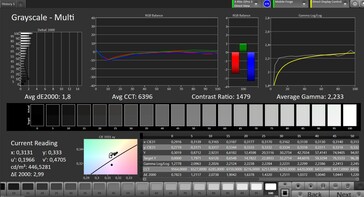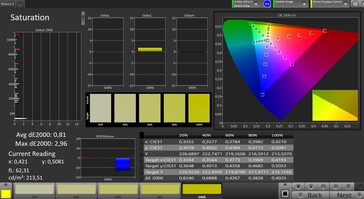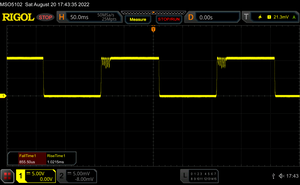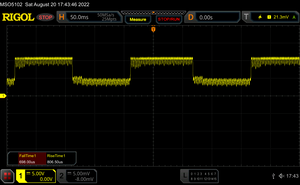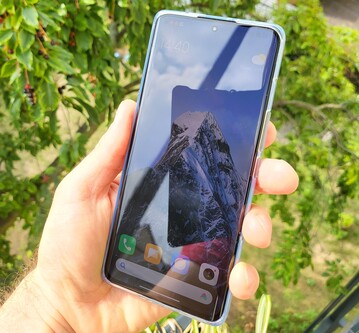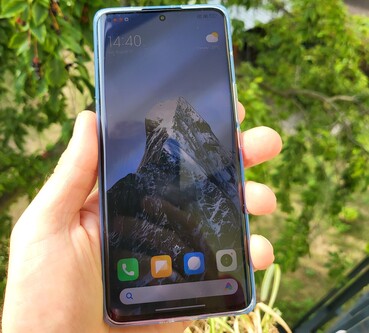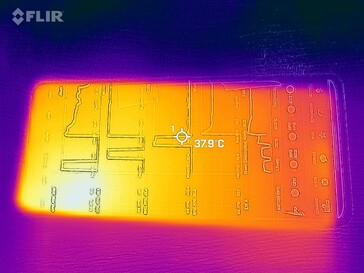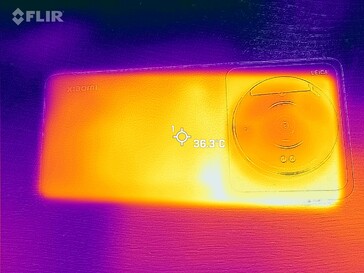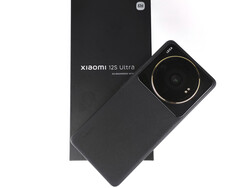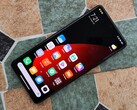Xiaomi 12S Ultra review: 5G smartphone with huge Leica camera leaves us wondering
The Xiaomi 12S Ultra is a real high-end smartphone with the inbuilt Qualcomm Snapdragon 8+ Gen 1, UFS 3.1 storage, and a 6.73-inch 120 Hz LTPO display. Yet the highlight of the Xiaomi flagship is the camera module on the back, which houses a 50-megapixel sensor in a 1-inch format and was co-developed by Leica.
Hardly any other smartphone on the market offers such a large image sensor. From a purely technical point of view, even Sony's Xperia Pro-I only uses a part of the IMX 383, which also measures 2.54 centimeters (1 inch). The strong camera hardware is also accompanied by new Leticia software: The 12S Ultra can make use of two modes, the "Leica Authentic Look" for natural-looking pictures with stronger spatial depth and the "Leica Vibrant Look" for a brighter and warm atmosphere.
Possible Competitors in Comparison
Rating | Date | Model | Weight | Drive | Size | Resolution | Price |
|---|---|---|---|---|---|---|---|
| 88.8 % v7 (old) | 09 / 2022 | Xiaomi 12S Ultra SD 8+ Gen 1, Adreno 730 | 225 g | 256 GB UFS 3.1 Flash | 6.73" | 3200x1440 | |
| 89.4 % v7 (old) | 03 / 2022 | Samsung Galaxy S22 Ultra 5G Exynos 2200, Xclipse 920 | 228 g | 128 GB UFS 3.1 Flash | 6.80" | 3088x1440 | |
| 89.2 % v7 (old) | 04 / 2022 | Oppo Find X5 Pro SD 8 Gen 1, Adreno 730 | 221 g | 256 GB UFS 3.1 Flash | 6.70" | 3216x1440 | |
| 87.7 % v7 (old) | 08 / 2022 | Sony Xperia 1 IV SD 8 Gen 1, Adreno 730 | 185 g | 256 GB UFS 3.1 Flash | 6.50" | 3840x1644 | |
| 87.5 % v7 (old) | 08 / 2022 | ZTE Axon 40 Ultra SD 8 Gen 1, Adreno 730 | 204 g | 128 GB UFS 3.1 Flash | 6.80" | 2480x1116 |
Case - Xiaomi 12S Ultra with vegan leather
The ceramic case of the Mi 11 Ultra has been replaced by a kind of vegan leather in the Xiaomi 12S Ultra, which the manufacturer calls "Leica texture". As a result, the weight of the flagship has been reduced slightly from 234 to 225 grams. Yet the form factor has remained almost identical, meaning that it is still quite heavy and large in size in the user's hands. The weight distribution of the rather top-heavy upper-class smartphone could have also been dealt with better.
There are no compromises in terms of haptics due to the relatively soft back, but the ceramic material of the predecessor feels more valuable - but this is probably more a question of individual taste. On the other hand, greasy fingerprints are well concealed by the textured surface.
The front of the Xiaomi 12S Ultra is made of scratch-resistant Corning Gorilla Glass Victus, which blends slightly into the metal frame. The transition between the frame and the glass could have been rounder for our taste, so the design remains somewhat angular. The ratio between the display and the front of the device is a good 89% thanks to the relatively thin bezel, whereas the bezel of a Galaxy S22 Ultra is even thinner.
The workmanship is first-rate and the installed keys sit firmly in the frame. In addition, the case is officially IP68-certified, making the Xiaomi 12S Ultra both dust- and waterproof.
Equipment - Xiaomi smartphone with USB 2.0
The Xiaomi 12S Ultra is available in three storage variants, starting with the basic version with 8 GB of RAM and 256 GB of internal storage up to the top model, which houses 12 GB and 512 GB. The UFS 3.1 storage in our review sample has a capacity of 256 GB, but only 224 GB is available in the state of delivery. The high-end smartphone's internal storage cannot be expanded.
The Xiaomi flagship's features include an IR blaster, USB OTG for the quick connection of external accessories, and wireless image transfer of screen contents. Data can only be transferred very slowly via the Type-C port on the underside of the case due to the USB 2.0 standard. Wired image transfer, like in the competition, is therefore not possible with the Xiaomi 12S Ultra.
Software - Xiaomi smartphone with Android 12
The operating system of the Xiaomi 12S Ultra is based on Android 12. At the time of review, the latest security patch installed was from July and thus relatively up to date. Whether the update guarantee of the global Xiaomi 12 series, i.e. three major Android updates and four years of security updates, also applies to the top model that is exclusive to China, is something that we are unable to ascertain.
As with the Chinese versions of Xiaomi phones, the in-house software of the 12S Ultra does not support Google services such as the Play Store ex-factory. Instead, Chinese services and Xiaomi's own services are used. Unlike Huawei's smartphones, the user does not have to do without Google services. The Google frameworks are already preinstalled out of the box, so only the Play Store has to be installed manually. However, no other languages can be selected outside of Chinese and English.
Communication & GNSS - Xiaomi 12S Ultra with fast WLAN
Xiaomi uses Bluetooth 5.2 and an NFC chip for the communication modules. There is also Play Protect certification, so payment services such as Google Pay should work with the Xiaomi 12S Ultra.
The flagship offers WiFi 6 and 8x8 multi-user MIMO for home WLAN, which ensure high and relatively constant transfer rates. In combination with our Asus ROG Rapture GT-AXE11000 reference router, the Xiaomi smartphone achieves transmission rates of over 900 Mbps, but did not recognize the 6 GHz range under testing.
The connectivity features make clear that the Xiaomi 12S Ultra is not intended for German-speaking countries. It only supports access to 15 LTE bands and does not cover all relevant LTE frequencies for local use. Band 20 and 28 have been omitted. 5G is available for fast internet, but without mmWave support.
| Networking | |
| iperf3 receive AXE11000 | |
| Sony Xperia 1 IV | |
| Xiaomi 12S Ultra | |
| ZTE Axon 40 Ultra | |
| Oppo Find X5 Pro | |
| Average of class Smartphone (52 - 1721, n=177, last 2 years) | |
| Samsung Galaxy S22 Ultra 5G | |
| iperf3 transmit AXE11000 | |
| Sony Xperia 1 IV | |
| Xiaomi 12S Ultra | |
| Oppo Find X5 Pro | |
| ZTE Axon 40 Ultra | |
| Average of class Smartphone (49.8 - 1828, n=177, last 2 years) | |
| Samsung Galaxy S22 Ultra 5G | |
| iperf3 transmit AXE11000 6GHz | |
| Sony Xperia 1 IV | |
| Samsung Galaxy S22 Ultra 5G | |
| Average of class Smartphone (508 - 1945, n=94, last 2 years) | |
| iperf3 receive AXE11000 6GHz | |
| Samsung Galaxy S22 Ultra 5G | |
| Sony Xperia 1 IV | |
| Average of class Smartphone (451 - 1870, n=94, last 2 years) | |
The localization capabilities of the Xiaomi 12S Ultra are anything but perfect. In order to assess its tracking accuracy in practice, we took the Xiaomi smartphone on a short trip and recorded the route with a Garmin Venu 2 for comparison.
The deviations in the detailed view of the GPS recording are sometimes very pronounced, resulting in notable inaccuracies in the course of the route. Most of the main satellite systems in dual-band are used for localization, such as Beidou (B1I + B1C+ B2a), GPS (L1 + L5), Galileo (E1 + E5a), GLONASS (G1) and QZSS (L1 + L5). However, changing direction poses problems for the Xiaomi 12S Ultra. In view of the fast positioning, even indoors, and the wide satellite selection, the tracking deficits are unusual and possibly related to the MIUI's frequent restrictive energy-saving measures.
Telephony & Voice Quality - Xiaomi smartphone with dual SIM
The Chinese flagship from Xiaomi supports two nano-SIM cards and dual-VoLTE HD as well as dual-5G. Under testing, however, VoLTE is not supported with a Telekom SIM card. We were unable find out to what extent eSIM functionality is available from the data sheet on the Chinese homepage. We only found the in-house Mi SIM, which only works in China, in the settings.
Voice quality via the Telekom network is good: Voices are clearly reproduced and also characterized as clear by our call partner.
Video calls via Skype using the inbuilt front-facing camera also functioned flawlessly under testing. Call quality via the built-in speaker is also good, and the inbuilt microphone transmits voices loudly and clearly.
Cameras - Xiaomi smartphone with triple cam
The high-resolution 32 MP selfie camera, which sits in a punch hole at the front, captures sharp and detailed images. However, the flagship has weaknesses in the field of vlogging because only 1080p videos are possible.
On the back, the Xiaomi 12S Ultra has a Leica camera system - Summicron 1:1.9-4.1 / 13-120 ASPH to be exact - that includes three rear lenses. In addition to the 1-inch Sony IMX989 with 50 megapixels (35 mm equivalent focal length: 23 mm, f/1.9), two 48-megapixel sensors are used for the ultra-wide (13 mm, f/2.2) and periscope (120 mm, f/4.1) cameras.
The Sony IMX989 offers very nice image sharpness in bright light without artificial over-sharpening, appealing colors and strong dynamics. The exposure also masters difficult image areas with bright lenses very well. Due to the 1-inch sensor, backgrounds are mostly blurred even in photo mode, which adds a special touch to the photos of the Xiaomi 12S Ultra compared to a Galaxy S22 Ultra or iPhone 13 Pro.
The Xiaomi smartphone also performs well in low-light scenarios. The sensor captures a lot of ambient light and the autofocus works satisfactorily in the dark, although we would have liked a little more sharpness. The camera software only does a little sharpening here. The dynamics in the photo, especially in the candle area, are first-rate.
The telephoto camera with 5x optical zoom and OIS achieves really good results up to a magnification of 10x. Images are characterized by lots of detail and a good sharpness in daylight. However, the ultra-wide-angle cam is visibly inferior to the main camera. The Xiaomi 12S Ultra also lacks sharpness in wide-angle shots compared to the camera elite.
Video Recordings
Videos can be recorded with the Xiaomi 12S Ultra in up to 8K resolution at 30 frames per second, in UHD quality at 60 fps, and even in 960 fps at 1080p. Stabilization works very well and the lenses (ultra/wide-angle) can be changed during recording at 4K30. Xiaomi has succeeded in combining consistent color- and white balance here.
Image comparison
Choose a scene and navigate within the first image. One click changes the position on touchscreens. One click on the zoomed-in image opens the original in a new window. The first image shows the scaled photograph of the test device.
Main cameraMain cameraLow lightUltra wide angleOur color analysis with the ColorChecker Passport reveals a satisfactory deviation compared to the actual reference colors, although green tones in particular are visibly brighter. Under controlled lighting conditions, there are also visible differences in the gray tones.
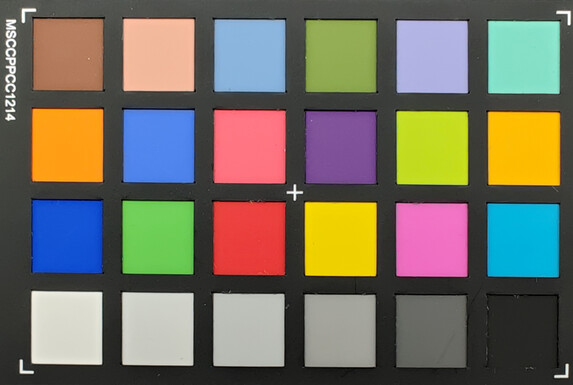
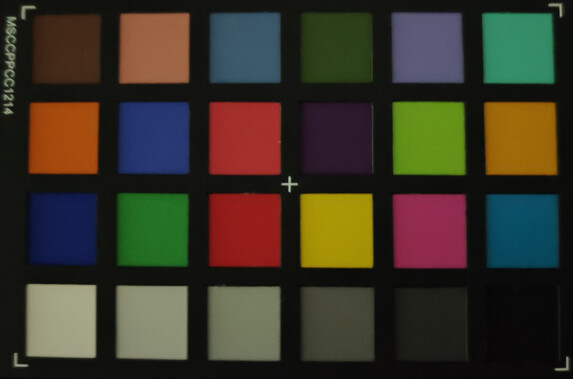
Accessories & Warranty - Xiaomi 12S Ultra with power adapter
The Xiaomi 12S Ultra comes with a 67-watt modular power adapter, a USB cable and a protective case shell. A protective film is also installed ex works. In addition, our lending partner, TradingShenzhen, supplemented the Chinese version of our review sample with an EU adapter for the charger and a USB OTG adapter.
The warranty for the Xiaomi smartphone is 12 months. With our imported sample from TradingShenzhen, we have the option of sending the smartphone to a German shipping address in the event of a warranty claim.
Input Devices & Operation - Xiaomi smartphone with 240 Hz
Users of the Xiaomi 12S Ultra will benefit from a high refresh rate of 120 Hz as well as a sampling rate of up to 240 Hz. The glass surface has excellent gliding properties and recognizes up to ten touches accurately. Typing on the high-end smartphone is also very pleasant. Xiaomi also installs a great vibration motor, which provides nice haptic feedback in everyday use.
The fingerprint sensor of the Xiaomi 12S Ultra has been integrated into the display like in most flagships and is thus invisible. The optical sensor responds quickly and also detects the finger accurately. However, this is not ultrasonic technology like in the Samsung Galaxy S22 Ultra, which is even more secure and less sensitive to unclean fingers. Those wanting to use face recognition to unlock the screen can do so via the front-facing camera, but biometric identification with the face is not very secure due to the 2D method.
Display - Xiaomi smartphone with OLED
At a resolution of 3200x1440, digital content is displayed sharply and the high refresh rate of 120 Hz is also on par with the competition. The LTPO 2.0 panel can be lowered down to 1 Hz via adaptive control, which we confirmed by looking at the developer settings.
Our brightness measurements of the Xiaomi 12S Ultra are somewhat disappointing. The 6.73-inch Super AMOLED display is sufficiently bright at over 800 cd/m², but a Galaxy S22 Ultra is much brighter in our measurements. We also tested the display luminance with the more realistic APL18, where we registered a high brightness level of 983 cd/m², but still far from the manufacturer's specification of 1500 nits. It is possible that the panel of the Xiaomi smartphone can reach the specified brightness of over 1000 cd/m² in certain scenarios, but this is unlikely to be relevant in everyday use. For comparison, a Galaxy S22 Ultra almost completely reaches the advertised specification of 1,800 nits with 1,788 cd/m² in our APL18 test.
For brightness control, the Xiaomi smartphone uses pulse width modulation (PWM) at a frequency of 122-366 Hz, but the period curve is very constant, similar to DC dimming. An extra anti-flicker mode can also be found in the developer settings.
| |||||||||||||||||||||||||
Brightness Distribution: 91 %
Center on Battery: 831 cd/m²
Contrast: ∞:1 (Black: 0 cd/m²)
ΔE ColorChecker Calman: 1.03 | ∀{0.5-29.43 Ø4.78}
ΔE Greyscale Calman: 1.8 | ∀{0.09-98 Ø5}
99.7% sRGB (Calman 2D)
Gamma: 2.233
CCT: 6396 K
| Xiaomi 12S Ultra OLED, 3200x1440, 6.7" | Samsung Galaxy S22 Ultra 5G Dynamic AMOLED, 3088x1440, 6.8" | Oppo Find X5 Pro AMOLED, 3216x1440, 6.7" | Sony Xperia 1 IV OLED, 3840x1644, 6.5" | ZTE Axon 40 Ultra AMOLED, 2480x1116, 6.8" | Xiaomi Mi 11 Ultra AMOLED, 3200x1440, 6.8" | |
|---|---|---|---|---|---|---|
| Screen | 20% | 10% | 14% | -32% | -9% | |
| Brightness middle (cd/m²) | 831 | 1077 30% | 746 -10% | 890 7% | 682 -18% | 891 7% |
| Brightness (cd/m²) | 807 | 1093 35% | 744 -8% | 897 11% | 683 -15% | 888 10% |
| Brightness Distribution (%) | 91 | 97 7% | 97 7% | 97 7% | 94 3% | 99 9% |
| Black Level * (cd/m²) | ||||||
| Colorchecker dE 2000 * | 1.03 | 1.2 -17% | 0.9 13% | 0.9 13% | 1.8 -75% | 1.9 -84% |
| Colorchecker dE 2000 max. * | 3.06 | 2 35% | 1.6 48% | 2.4 22% | 4.7 -54% | 3.7 -21% |
| Greyscale dE 2000 * | 1.8 | 1.3 28% | 1.6 11% | 1.4 22% | 2.4 -33% | 1.3 28% |
| Gamma | 2.233 99% | 2.37 93% | 2.23 99% | 2.21 100% | 2.16 102% | 2.3 96% |
| CCT | 6396 102% | 6526 100% | 6499 100% | 6320 103% | 6634 98% | 6527 100% |
* ... smaller is better
Screen Flickering / PWM (Pulse-Width Modulation)
| Screen flickering / PWM detected | 186.5 Hz | ||
The display backlight flickers at 186.5 Hz (worst case, e.g., utilizing PWM) . The frequency of 186.5 Hz is relatively low, so sensitive users will likely notice flickering and experience eyestrain at the stated brightness setting and below. In comparison: 53 % of all tested devices do not use PWM to dim the display. If PWM was detected, an average of 8108 (minimum: 5 - maximum: 343500) Hz was measured. | |||
Series of measurements at a fixed zoom level and different brightness settings
In addition to pronounced contrasts, the Xiaomi 12S Ultra offers HDR10+ and high color space coverage. Practically no differences are visible in sRGB. The panel is very well calibrated ex works, which is confirmed by our analysis with a photospectrometer. The CalMAN software results in very low average Delta-E deviations of 1 (colors) and 1.8 (grayscale), respectively. However, the smaller sRGB color space has to be used to achieve high accuracy.
Display Response Times
| ↔ Response Time Black to White | ||
|---|---|---|
| 1.9 ms ... rise ↗ and fall ↘ combined | ↗ 0.9 ms rise | |
| ↘ 1 ms fall | ||
| The screen shows very fast response rates in our tests and should be very well suited for fast-paced gaming. In comparison, all tested devices range from 0.1 (minimum) to 240 (maximum) ms. » 9 % of all devices are better. This means that the measured response time is better than the average of all tested devices (20.2 ms). | ||
| ↔ Response Time 50% Grey to 80% Grey | ||
| 1.5 ms ... rise ↗ and fall ↘ combined | ↗ 0.7 ms rise | |
| ↘ 0.8 ms fall | ||
| The screen shows very fast response rates in our tests and should be very well suited for fast-paced gaming. In comparison, all tested devices range from 0.165 (minimum) to 636 (maximum) ms. » 6 % of all devices are better. This means that the measured response time is better than the average of all tested devices (31.6 ms). | ||
The Xiaomi flagship can be used outdoors without limitations as long as automatic mode is enabled. The high brightness and great contrasts provide an appealing outdoor experience in direct sunlight. However, a Galaxy S22 Ultra has more brightness reserves as soon as reflections appear on the glass surface.
The viewing angle stability of the OLED panel is very good. Display content is shown relatively true to color and vividly even at flat viewing angles.
Performance - Xiaomi 12S Ultra with Qualcomm SoC
The Snapdragon 8+ Gen. 1 in the Xiaomi 12S Ultra is a 4 nm SoC and is based on three clusters, which consist of a prime core (Cortex X2), three performance cores (Cortex A710), and four power-saving units (Cortex A510). The processor can make use of the integrated Adreno 730 for graphics acceleration.
In our CPU benchmark tests, the Xiaomi 12S Ultra positions itself ahead of the Asus ROG Phone 6 Pro in Geekbench. Especially in multi-core performance, the Snapdragon 8+ Gen. 1 is superior to its predecessor.
Our positive impression from the CPU and system benchmarks is further reinforced by the graphics benchmarks: The Xiaomi smartphone ranks ahead of a ROG Phone 6 Pro in the offscreen rates. However, as expected, the Xiaomi 12S Ultra does not come close to the onscreen scores of the gaming phones due to the higher resolution. Although browsing seems very fast with the Snapdragon 8+ Gen. 1, the Xiaomi flagship produces mediocre or less-than-average results in the browser tests.
| GFXBench (DX / GLBenchmark) 2.7 | |
| T-Rex Onscreen | |
| Asus ROG Phone 6 Pro | |
| Xiaomi Mi 11 Ultra | |
| Xiaomi 12S Ultra | |
| Samsung Galaxy S22 Ultra 5G | |
| ZTE Axon 40 Ultra | |
| Sony Xperia 1 IV | |
| Oppo Find X5 Pro | |
| 1920x1080 T-Rex Offscreen | |
| Xiaomi 12S Ultra | |
| ZTE Axon 40 Ultra | |
| Oppo Find X5 Pro | |
| Asus ROG Phone 6 Pro | |
| Sony Xperia 1 IV | |
| Samsung Galaxy S22 Ultra 5G | |
| Xiaomi Mi 11 Ultra | |
| GFXBench 3.0 | |
| on screen Manhattan Onscreen OGL | |
| Asus ROG Phone 6 Pro | |
| ZTE Axon 40 Ultra | |
| Samsung Galaxy S22 Ultra 5G | |
| Xiaomi 12S Ultra | |
| Xiaomi Mi 11 Ultra | |
| Sony Xperia 1 IV | |
| Oppo Find X5 Pro | |
| 1920x1080 1080p Manhattan Offscreen | |
| Xiaomi 12S Ultra | |
| Asus ROG Phone 6 Pro | |
| ZTE Axon 40 Ultra | |
| Samsung Galaxy S22 Ultra 5G | |
| Oppo Find X5 Pro | |
| Xiaomi Mi 11 Ultra | |
| Sony Xperia 1 IV | |
| GFXBench 3.1 | |
| on screen Manhattan ES 3.1 Onscreen | |
| Asus ROG Phone 6 Pro | |
| ZTE Axon 40 Ultra | |
| Xiaomi 12S Ultra | |
| Samsung Galaxy S22 Ultra 5G | |
| Xiaomi Mi 11 Ultra | |
| Sony Xperia 1 IV | |
| Oppo Find X5 Pro | |
| 1920x1080 Manhattan ES 3.1 Offscreen | |
| Xiaomi 12S Ultra | |
| Asus ROG Phone 6 Pro | |
| Samsung Galaxy S22 Ultra 5G | |
| Xiaomi Mi 11 Ultra | |
| ZTE Axon 40 Ultra | |
| Sony Xperia 1 IV | |
| Oppo Find X5 Pro | |
| Jetstream 2 - 2.0 Total Score | |
| Average of class Smartphone (23.8 - 387, n=149, last 2 years) | |
| Asus ROG Phone 6 Pro (Chrome 103) | |
| ZTE Axon 40 Ultra (Chrome 103.0.5060.71) | |
| Average Qualcomm Snapdragon 8+ Gen 1 (76.2 - 204, n=23) | |
| Sony Xperia 1 IV (Chrome 103) | |
| Xiaomi 12S Ultra (Chrome 104) | |
| Oppo Find X5 Pro (Chrome 99) | |
| Samsung Galaxy S22 Ultra 5G (Chrome 99) | |
| Xiaomi Mi 11 Ultra (Chrome91) | |
| Speedometer 2.0 - Result 2.0 | |
| Average of class Smartphone (15.2 - 643, n=122, last 2 years) | |
| Asus ROG Phone 6 Pro (Chrome 103) | |
| Average Qualcomm Snapdragon 8+ Gen 1 (69.1 - 196, n=18) | |
| ZTE Axon 40 Ultra (Chrome 103.0.5060.71) | |
| Sony Xperia 1 IV (Chrome 103) | |
| Samsung Galaxy S22 Ultra 5G (Chrome 99) | |
| Oppo Find X5 Pro (Chrome 99) | |
| Xiaomi Mi 11 Ultra (Chrome91) | |
| Xiaomi 12S Ultra (Chrome 104) | |
| WebXPRT 3 - Overall | |
| Asus ROG Phone 6 Pro (Chrome 103) | |
| Average of class Smartphone (38 - 380, n=31, last 2 years) | |
| Sony Xperia 1 IV (Chrome 103) | |
| Average Qualcomm Snapdragon 8+ Gen 1 (106 - 224, n=14) | |
| Xiaomi 12S Ultra (Chrome 104) | |
| Xiaomi Mi 11 Ultra (Chrome91) | |
| Oppo Find X5 Pro (Chrome 99) | |
| Samsung Galaxy S22 Ultra 5G (Chrome 99) | |
| ZTE Axon 40 Ultra (Chrome 103.0.5060.71) | |
| Octane V2 - Total Score | |
| Asus ROG Phone 6 Pro (Chrome 103) | |
| Average of class Smartphone (2228 - 121337, n=197, last 2 years) | |
| ZTE Axon 40 Ultra (Chrome 103.0.5060.71) | |
| Sony Xperia 1 IV (Chrome 103) | |
| Average Qualcomm Snapdragon 8+ Gen 1 (17622 - 61536, n=24) | |
| Oppo Find X5 Pro (Chrome 99) | |
| Xiaomi 12S Ultra (Chrome 104) | |
| Samsung Galaxy S22 Ultra 5G (Chrome 99) | |
| Xiaomi Mi 11 Ultra (Chrome91) | |
| Mozilla Kraken 1.1 - Total | |
| Xiaomi Mi 11 Ultra (Chrome91) | |
| Samsung Galaxy S22 Ultra 5G (Chrome 99) | |
| Average of class Smartphone (257 - 28190, n=154, last 2 years) | |
| Oppo Find X5 Pro (Chrome 99) | |
| Xiaomi 12S Ultra (Chrome 104) | |
| Average Qualcomm Snapdragon 8+ Gen 1 (665 - 1707, n=22) | |
| Asus ROG Phone 6 Pro (Chrome 103) | |
| Sony Xperia 1 IV (Chrome 103) | |
| ZTE Axon 40 Ultra (Chrome 103.0.5060.71) | |
* ... smaller is better
The Xiaomi 12S Ultra runs very smoothly and almost without lags in everyday use. The system performance is first-rate and the loading times of applications are very short. This is also due to the fast read and write rates of the UFS storage, where the 12S Ultra performs very well.
| Xiaomi 12S Ultra | Samsung Galaxy S22 Ultra 5G | Oppo Find X5 Pro | Sony Xperia 1 IV | ZTE Axon 40 Ultra | Xiaomi Mi 11 Ultra | Asus ROG Phone 6 Pro | Average 256 GB UFS 3.1 Flash | Average of class Smartphone | |
|---|---|---|---|---|---|---|---|---|---|
| AndroBench 3-5 | -21% | -41% | -13% | -22% | -25% | -3% | -18% | 1% | |
| Sequential Read 256KB (MB/s) | 1963.45 | 1653 -16% | 1410 -28% | 1982.56 1% | 1638.15 -17% | 1928 -2% | 1949.16 -1% | 1757 ? -11% | 2228 ? 13% |
| Sequential Write 256KB (MB/s) | 1475.43 | 1074 -27% | 894 -39% | 1262.21 -14% | 1065.13 -28% | 756 -49% | 1454.5 -1% | 1204 ? -18% | 1851 ? 25% |
| Random Read 4KB (MB/s) | 309.21 | 322.3 4% | 183.7 -41% | 293.95 -5% | 313.35 1% | 259.3 -16% | 297.48 -4% | 287 ? -7% | 296 ? -4% |
| Random Write 4KB (MB/s) | 489.58 | 273.1 -44% | 210.4 -57% | 334.19 -32% | 273.19 -44% | 329.7 -33% | 459.66 -6% | 318 ? -35% | 337 ? -31% |
Gaming - Xiaomi 12S Ultra manages 120 fps
In order to assess the GPU power in everyday use, we took a closer look at a few Android titles with our GameBench tool. On paper, a strong SoC and a fast 120 Hz OLED display promise a lot of gaming fun. However, the high waste heat of the Qualcomm SoC somewhat spoils the potential of the Xiaomi 12S Ultra.
In PUBG Mobile, 60 fps is possible in HD with a cool system. As soon as the Snapdragon 8+ Gen. 1 comes under prolonged stress, only 50 fps is generated. Constant 60 fps is then only possible at the lowest graphics settings. The flagship operates at 40 fps at the highest detail level (UHD).
Armajet initially runs at a high frame rate, but this steadily decreases over time. The arena shooter theoretically supports the full 120 Hz of the panel, but the 12S Ultra only manages 72 fps on average.
Emissions - Xiaomi smartphone gets warm
Temperature
The surface temperatures of the Xiaomi 12S Ultra increase noticeably under prolonged load and the case gets very warm in places, especially in the upper third. To better assess the performance of the Qualcomm SoC in this situation, we carried out stress tests with 3DMark.
The Wild Life stress tests show a similar picture to that of smartphones with the Snapdragon 8 Gen 1, albeit at a higher performance level. Unlike OnePlus, Xiaomi throttles its smartphones noticeably to avoid continuous overheating. We were also able to induce a system crash in the 12S Ultra, but a single stress test is not enough here.
(-) The maximum temperature on the upper side is 47.4 °C / 117 F, compared to the average of 35.2 °C / 95 F, ranging from 21.9 to 247 °C for the class Smartphone.
(±) The bottom heats up to a maximum of 40.3 °C / 105 F, compared to the average of 34 °C / 93 F
(+) In idle usage, the average temperature for the upper side is 26.7 °C / 80 F, compared to the device average of 32.9 °C / 91 F.
3DMark Wild Life Stress Test
| 3DMark | |
| Wild Life Stress Test Stability | |
| Asus ROG Phone 6 Pro | |
| Xiaomi Mi 11 Ultra | |
| Oppo Find X5 Pro | |
| Sony Xperia 1 IV | |
| ZTE Axon 40 Ultra | |
| Samsung Galaxy S22 Ultra 5G | |
| Xiaomi 12S Ultra | |
| Wild Life Extreme Stress Test | |
| Asus ROG Phone 6 Pro | |
| Xiaomi Mi 11 Ultra | |
| Xiaomi 12S Ultra | |
| ZTE Axon 40 Ultra | |
| Oppo Find X5 Pro | |
| Sony Xperia 1 IV | |
| Samsung Galaxy S22 Ultra 5G | |
Speakers
The flagship from Xiaomi features a symmetrical dual speaker system on the top and bottom of the case. The 12S Ultra's symmetrical speaker layout produces true stereo sound, optimized by Harman Kardon.
The smartphone generates very linear mids and highs, even though a dip in the pink noise diagram is visible in the super high tones. Bass is present, but hardly perceptible.
Xiaomi did not include an audio jack, but music playback is possible via the USB-C port. Those wanting to use wireless headphones or Bluetooth speakers have access to AAC, aptX, aptX-HD and LDAC as well as LHDC.
Xiaomi 12S Ultra audio analysis
(+) | speakers can play relatively loud (83.2 dB)
Bass 100 - 315 Hz
(-) | nearly no bass - on average 21.8% lower than median
(±) | linearity of bass is average (9.2% delta to prev. frequency)
Mids 400 - 2000 Hz
(+) | balanced mids - only 3.9% away from median
(+) | mids are linear (6.1% delta to prev. frequency)
Highs 2 - 16 kHz
(+) | balanced highs - only 3.2% away from median
(+) | highs are linear (5.2% delta to prev. frequency)
Overall 100 - 16.000 Hz
(±) | linearity of overall sound is average (17.9% difference to median)
Compared to same class
» 15% of all tested devices in this class were better, 8% similar, 76% worse
» The best had a delta of 11%, average was 35%, worst was 134%
Compared to all devices tested
» 36% of all tested devices were better, 8% similar, 56% worse
» The best had a delta of 4%, average was 24%, worst was 134%
Samsung Galaxy S22 Ultra 5G audio analysis
(+) | speakers can play relatively loud (90.2 dB)
Bass 100 - 315 Hz
(-) | nearly no bass - on average 24.4% lower than median
(±) | linearity of bass is average (8.8% delta to prev. frequency)
Mids 400 - 2000 Hz
(±) | higher mids - on average 6.3% higher than median
(+) | mids are linear (4.8% delta to prev. frequency)
Highs 2 - 16 kHz
(±) | higher highs - on average 5.6% higher than median
(+) | highs are linear (4.1% delta to prev. frequency)
Overall 100 - 16.000 Hz
(±) | linearity of overall sound is average (18.5% difference to median)
Compared to same class
» 20% of all tested devices in this class were better, 9% similar, 71% worse
» The best had a delta of 11%, average was 35%, worst was 134%
Compared to all devices tested
» 41% of all tested devices were better, 8% similar, 52% worse
» The best had a delta of 4%, average was 24%, worst was 134%
Battery Life - Xiaomi 12S Ultra with Fast Charging
Power Consumption
The Xiaomi 12S Ultra can be charged either via USB-C with up to 67 watts or wirelessly with a maximum of 50 watts. Reverse wireless charging with a maximum of 10 watts is also available. In addition to MI FC 2.0, common fast charging protocols such as QC4 or PD3.0 are also supported.
Xiaomi's proprietary Surge G1 chipset is supposed to improve the runtimes of the 4,840 mAH strong battery. At around 46 minutes, the high-end smartphone does not charge quite as fast as the Xiaomi 12S Pro, but the charging times are still reasonable.
The Snapdragon 8+ Gen 1's power consumption is significantly lower than in smartphones with the Qualcomm predecessor, especially under load. A more efficient cryo CPU seems to be primarily responsible for this.
| Off / Standby | |
| Idle | |
| Load |
|
Key:
min: | |
| Xiaomi 12S Ultra 4860 mAh | Samsung Galaxy S22 Ultra 5G 5000 mAh | Oppo Find X5 Pro 5000 mAh | Sony Xperia 1 IV 5000 mAh | ZTE Axon 40 Ultra 5000 mAh | Asus ROG Phone 6 Pro 6000 mAh | Average Qualcomm Snapdragon 8+ Gen 1 | Average of class Smartphone | |
|---|---|---|---|---|---|---|---|---|
| Power Consumption | -20% | -20% | -44% | -30% | -9% | -49% | -48% | |
| Idle Minimum * (Watt) | 0.9 | 0.58 36% | 1.24 -38% | 1.06 -18% | 0.88 2% | 0.8 11% | 1.006 ? -12% | 0.842 ? 6% |
| Idle Average * (Watt) | 1 | 0.71 29% | 1.39 -39% | 1.71 -71% | 1.57 -57% | 1.31 -31% | 1.834 ? -83% | 1.439 ? -44% |
| Idle Maximum * (Watt) | 1.2 | 1.16 3% | 1.42 -18% | 1.89 -58% | 1.6 -33% | 1.36 -13% | 1.984 ? -65% | 1.624 ? -35% |
| Load Average * (Watt) | 3.5 | 7.07 -102% | 3.58 -2% | 4.99 -43% | 5.06 -45% | 3.77 -8% | 5.68 ? -62% | 7.03 ? -101% |
| Load Maximum * (Watt) | 6.9 | 11.32 -64% | 6.99 -1% | 8.91 -29% | 7.91 -15% | 7.04 -2% | 8.44 ? -22% | 11.3 ? -64% |
* ... smaller is better
Power Consumption: Geekbench (150 cd/m²)
Power Consumption: GFXBench (150 cd/m²)
Battery Life
We were pleasantly surprised by the battery runtimes of the Xiaomi 12S Ultra, which are very good for the installed hardware. We carried out our tests with QHD-Plus resolution and at an adaptive refresh rate of 120 Hz maximum. The Xiaomi flagship performs particularly well in the practical WLAN test with adjusted display brightness (150 cd/m²).
| Xiaomi 12S Ultra 4860 mAh | Samsung Galaxy S22 Ultra 5G 5000 mAh | Oppo Find X5 Pro 5000 mAh | Sony Xperia 1 IV 5000 mAh | ZTE Axon 40 Ultra 5000 mAh | |
|---|---|---|---|---|---|
| Battery runtime | 6% | -8% | -38% | 16% | |
| Reader / Idle (h) | 29.4 | 32.9 12% | 21.2 -28% | 16.3 -45% | 40.8 39% |
| H.264 (h) | 18.5 | 18 -3% | 19 3% | 10.6 -43% | 24.5 32% |
| WiFi v1.3 (h) | 15.9 | 14.1 -11% | 13.1 -18% | 7.1 -55% | 16.3 3% |
| Load (h) | 5.5 | 6.8 24% | 6.1 11% | 5 -9% | 4.9 -11% |
Pros
Cons
Verdict on the Xiaomi 12S Ultra
Once again, the Ultra model from Xiaomi focuses heavily on the camera system, strengthened by a new partnership with Leica, which results in a huge Sony IMX989 that performs particularly well with excellent image quality and natural bokeh. However, the Xiaomi 12S Ultra lags behind comparable devices such as the Oppo Find X5 Pro due to the lack of a UHD video recording option on the front camera and the somewhat lower-quality ultra-wide-angle camera.
Excluding these minor points of criticism, one has to wonder why the Chinese manufacturer has chosen USB 2.0 for a flagship smartphone in 2022 and why the in-house 120-watt fast charging technology is only reserved for the upper class and not used in the high-end segment. The otherwise very good Super AMOLED display is also clearly inferior to competing Samsung devices in terms of brightness. A Galaxy S22 Ultra, for example, is noticeably brighter in our benchmarks.
Xiaomi's 12S Ultra is a high-quality and very well-equipped smartphone, which will hopefully soon make its way to Europe. Why only China is able to enjoy the benefits of the true 2022 flagship is incomprehensible.
Similarly to OnePlus, the switch from the Snapdragon 8 Gen. 1 in the global Xiaomi smartphones to the new Plus version of the Qualcomm SoC has fizzled out somewhat. Without appropriate throttling of the chipset, even Xiaomi is unable to keep the waste heat of the Snapdragon 8+ Gen. 1 under control. Such a chipset requires a gaming smartphone such as the Asus ROG Phone 6 Pro, which actively keeps surfaces cool with fans, among other things.
Price and Availability
The Xiaomi 12S Ultra can be purchased for around US$1000 via import companies such as our loan partner Trading Shenzhen.
Xiaomi 12S Ultra
- 09/01/2022 v7 (old)
Marcus Herbrich





